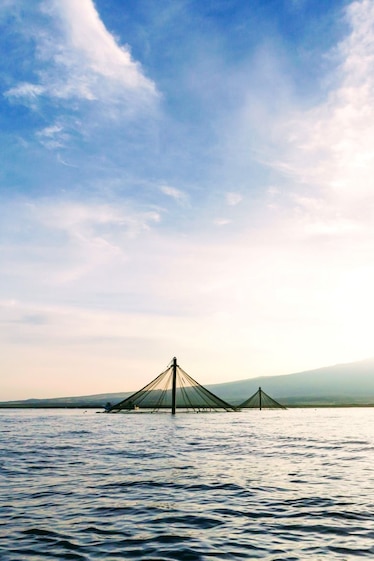The fish farm is only half a mile from the Island of Hawaii's coast, but the water is deep, up to 240 feet, and the current is strong. Breaking the blue horizon, two of Blue Ocean Mariculture’s 110-foot-tall netted pyramids protrude, swaying with the waves. Fifty feet of each net pen floats underwater.
Inside these enclosures are about 100,000 Hawaiian kanpachi, roughly five pounds each, waiting to be harvested and sold. A type of yellowtail, I watched the fish flash streaks of silver when the sun hit just right below the water’s surface. This species has become increasingly popular among American chefs, proving versatile in dishes with a meaty yet flakey texture.
The United States imports 90 percent of the seafood it consumes—from shrimp to salmon to crab. Across the globe, more than 50 percent of seafood comes from aquaculture.
Along the coasts in U.S. state waters, you can find shellfish farms from Virginia to Maine, trout hatcheries in Washington State, and salmon recirculating aquaculture systems in Florida. But the country only has one offshore farm, the one off the coast of Hawaii.
With land resources exhausted for agricultural use—about 52 percent of U.S. land is used for agriculture production—and overfishing eliminating wild fish stocks, offshore aquaculture presents an opportunity to raise more protein in an environmentally sustainable manner.
(What is aquaculture? It could be the solution to overfishing.)
“Aquaculture seems to present not just the greatest potential but perhaps the only potential if we're looking into producing additional [protein] required to feed the world,” says Daniel Benetti, director of aquaculture at the University of Miami in Florida.
Anti-aquaculture activists claim that fish escapes and disease are major threats to the surrounding ecosystems—and in the past, they have been. But with advancements in technology and fish feed, recent studies show offshore farms, when sited properly, pose little to no environmental threat.
Then why is Blue Ocean the only offshore aquaculture farm in the U.S.?
Offshore demonstrations
The concept of fish farming isn’t foreign to Hawaiians. The state has a rich and robust history of aquaculture; its people have relied on ancient techniques, like the use of fish ponds, for thousands of years.
But for an offshore farm today in any other state, receiving permits is a timely, costly, and fragmented process; the Environmental Protection Agency, U.S. Coast Guard, National Oceanic and Atmospheric Administration, Army Corps of Engineers, and the state all have a say and a role in issuing permits and reviewing business plans. The public has opportunities to weigh in throughout the process, and lawsuits are also common, such as an animal rights group that’s sued the Environmental Protection Agency for its approval for an offshore demonstration permit off the coast of Sarasota, Florida.
Blue Ocean's story began in 2001, when it launched as a project to demonstrate how an offshore farm would survive in and impact the ocean in Hawaii. With one net pen in the water, the company kept a close eye on water quality, fish health, and environmental impacts. It proved successful, and eight years later, the Hawaii-based company turned into the first and only commercially operating offshore farm to raise finfish in the U.S.
On a sunny day in June, I put on my mask and snorkel and jumped into the sea. The water a gradient blue, almost black, as I swam around the pen and tried to see the ocean floor—and couldn’t. Instead, and as evidence of the farm's cleanliness, coral, one of the most volatile and sensitive organisms, grew on the steel portions of the pens. Sealife such as sergeant majors, giant trevally, and monk seals were abundant, swimming around the cage, keeping an eye on me. I was told the sharks were there, too, but in deeper waters below; they’d be by the nets later in the day.
Neil Sims, the founder of Blue Ocean and now the CEO of the research and development company Ocean Era, isn’t done trying to expand offshore farms to other states. He regularly flies to Florida from Hawaii to pursue another demonstration project—which consists of one net pen—in the Gulf of Mexico.
He’s going on year six—and, because of permitting roadblocks, there isn’t a net pen in the Gulf.
Still, Sims says he’s not going to give up. “We need to be a bit more bold,” he says.
Future ocean farms
The biggest hurdle for offshore expansion is the permitting process, says Dick Jones, CEO of Blue Ocean.
Congress has its eye on the issue, however. Both the House and the Senate reintroduced a bipartisan bill called Advancing the Quality and Understanding of American Aquaculture (AQUAA) Act. The bill would create national standards for offshore aquaculture and clarify a regulatory system for farming fish in the U.S. ocean.
The Science-based Equitable Aquaculture Food (SEAfood) Act has also been introduced in the House with bipartisan support, which would authorize studies and pilot programs related to the development and production of offshore aquaculture.
Beyond Congress, the White House this year created the Ocean Climate Action Plan, in part looking to “reduce costs and time frames for siting and permitting for new and existing commercial-scale aquaculture operations.”
It’s evident the government is gaining a pulse on the issue, but timelines remain unclear for when decisions will be put into action.
“If both sides can agree on the areas of deviation and we can get legislation passed, the U.S. aquaculture industry will soar,” Jones says.
As I floated in the Pacific, I stared at the kanpachi in the cage, mesmerized as they moved in unison with each other, flowing with the current. They’re curious fish—where I swam they followed, 200,000 eyes watching.
Riding away on a boat, I watched the cages until the pyramids and crews became specs on the horizon, lost in the great Hawaiian sea.
